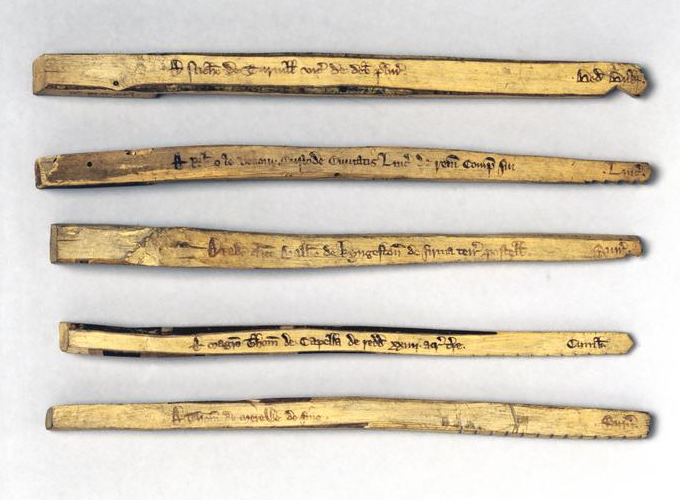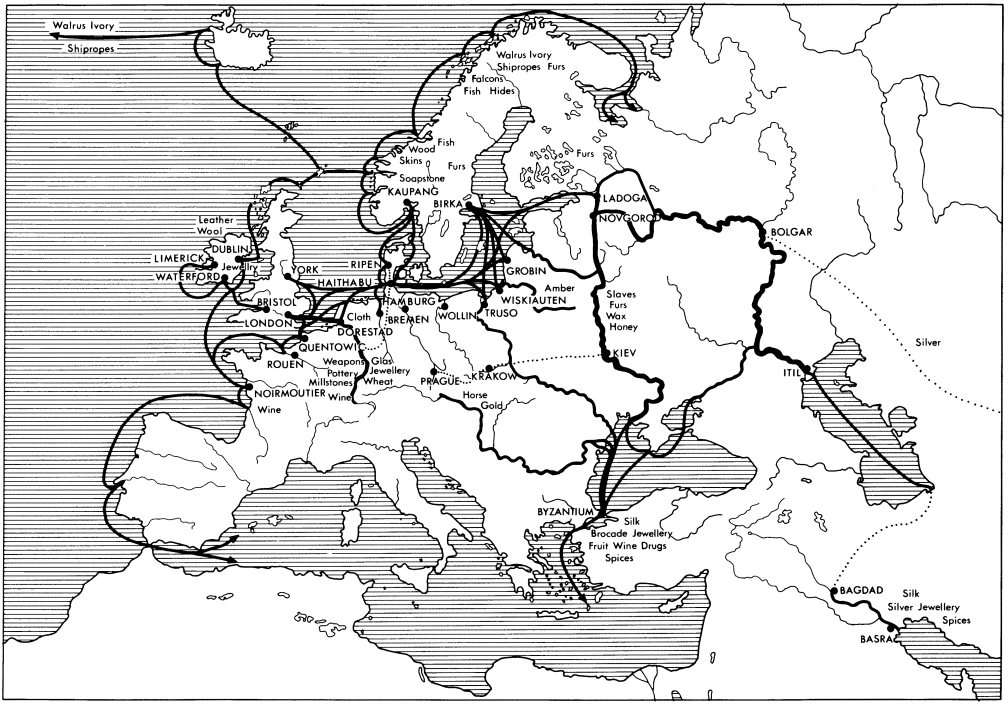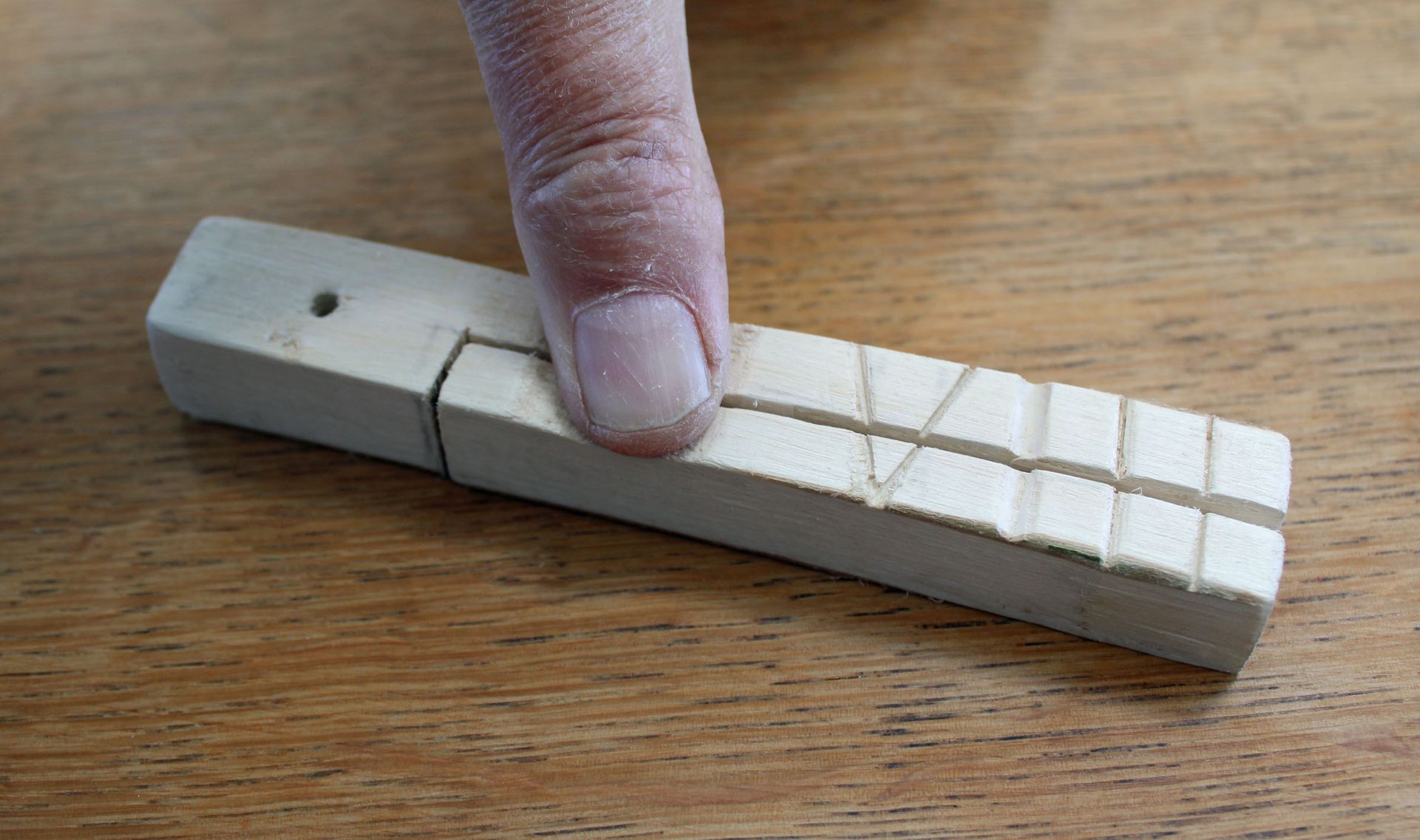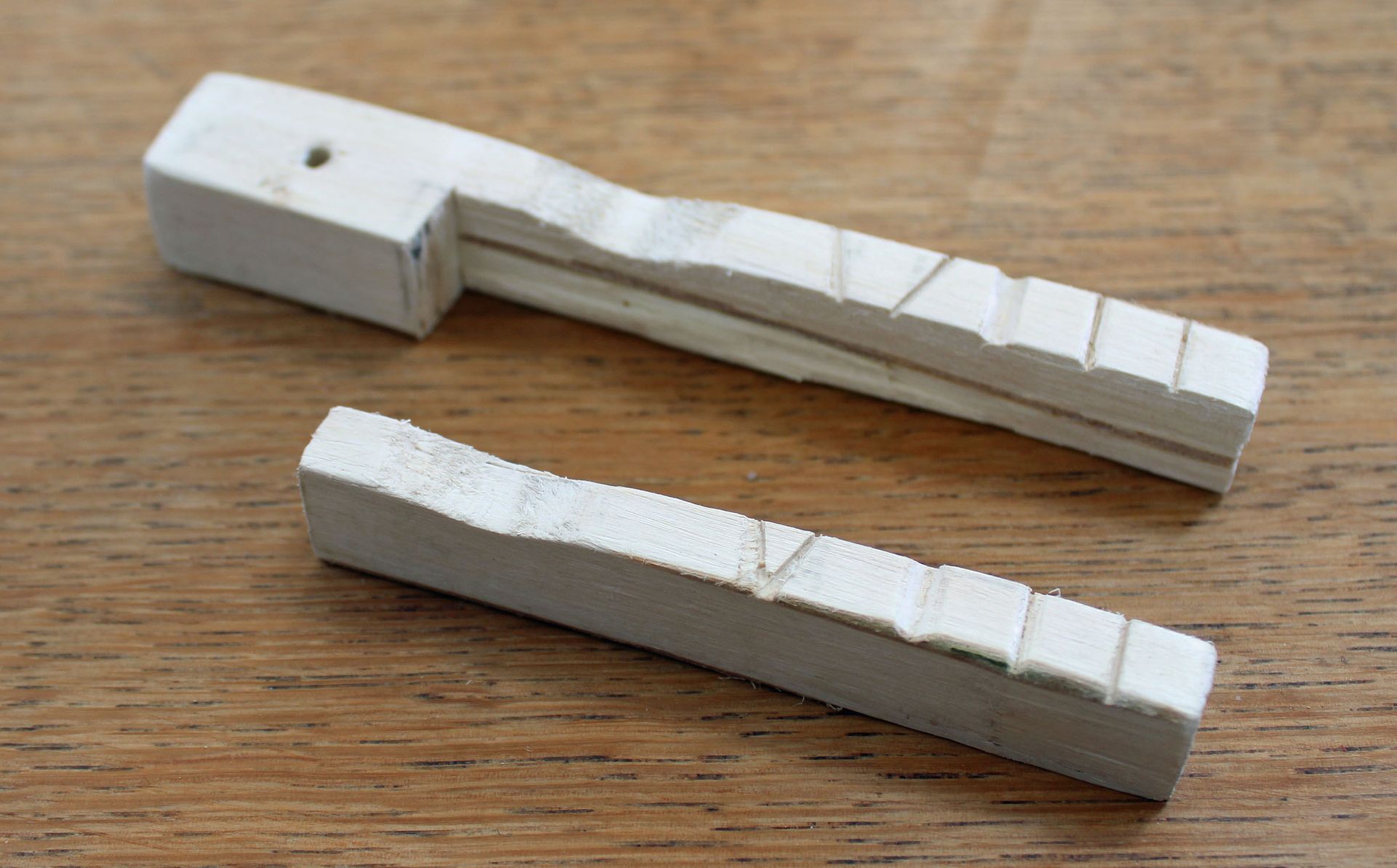The Secret History of the Tally Stick
Money as Debt
Geoffrey M. Hodgson
For tens of thousands of years, humans have cut notches into pieces of bone, ivory, wood or stone, to tally numbers of animals, objects, people, or events. These were simple accounting devices. They were cheap to obtain, and their users did not have to be literate.
Eventually, some tallies were modified to serve as a form of money. This involved splitting them into two pieces, one recording a debt, the other a credit. Mitchell Innes and others have claimed that split wooden tallies were preceded in Italy by broken cakes of bronze, dating back to 1000 BC or earlier. Some evidence indicates the use of split wooden tallies in Persia around 500 BC, from where their use may have spread to Greece. Marco Polo reported the use of tallies in China in the thirteenth century. Tally sticks recording tax debt have been unearthed in China that date from the seventh century. The use of bamboo money tallies in China persisted until modern times. It also seems that some bone tallies were used as money by the Mayans in Central America from the seventh century. (1)
The word tally has made its way into several Indo-European languages. In Latin, talea
means a cutting, or a twig. A similar word exists in several Romance languages, often denoting cutting or carving. It also passed to the French taille, with similar meanings, to which the senses of tally for reckoning and payment have been added. Old English had talu
for a reckoning or tally, but it used gield
for the payment itself.
The earliest archaeological evidence of split wooden tallies in Europe is in the City of Novgorod (in modern Russia) in the late tenth century AD. Novgorod had cultural and trading links with Constantinople and the Vikings. It used split wooden tallies in its trade, around the Baltic and the North Sea, to Scandinavia, northern Germany and Britain. Viking and Varangian traders may have been crucial in the spread of the split wooden tally. In Britain, split tallies were legally recognized as money from about 1100 until 1826. In France they were legally viable until 1854 or later. Their nineteenth century use was noted among Parisian bakers.(2)
Map of Europe in 1000 AD
Novgorod is ringed on top-right
Keeping a tally or record is different from making a payment. But in some languages the tal-
root was transferred to split tallies, which served as money. Today, a surviving cluster of words for “to pay” and “payment” indicate their association with the use of physical money-tallies, while these objects have since disappeared and are forgotten. Northern France had much Viking contact, including their invasion of what became Normandy. Northern parts of Germany traded with the Vikings, who moved inland via the Elbe, Rhine, Weser and other rivers. The Germans today use beszalen
for “to pay” and Zahlung
for “payment.” The earliest written evidence of these zal forms is in Old High German texts from the tenth century. The Danes speak of betale
and betaling
respectively. The Dutch use betalen
and betaling. For the Norwegians it is betale
and betaling. The Swedes use betala
and betalning. Britain and Ireland traded with the Vikings too. Hence the Welsh use talu
(pronounced tali) and taliad
for “to pay” and “payment.” Cornish has talas
for “payment.” In other Celtic languages, these tal- words are absent. They may have existed previously but disappeared. Modern English preserves the word tally for reckoning, but not for a payment. But in the other Northern European languages listed here, the tal- root is associated with paying and payments. It is likely that these are all linguistic survivals of Viking trade, over a large part of Northern Europe.
Viking Trade in Europe
From Jankuhn (1982)
Very few economists even mention the humble tally. But their history tells us something about the nature of money, as both Alfred Mitchell Innes and David Graeber appreciated. It shows that the history of money is not solely about precious metals, notes or coins. The same point is still highly relevant today. Data collected in 2011 testify that about 90 percent of money in the US has no physical existence at all, it consisted of electronic account records held by banks. In the UK it is 97 per cent. Money is not primarily physical. It is a social relation between debtors and creditors. As Geoffrey Ingham observed, money is a “social technology.” It rests on sovereign power and is regulated by laws. It is informational and relational, depending on legal and political institutions.(3)
The Magic Money Twig
All this is illustrated by the split tally. The sides of a twig of seasoned hazelwood or willow were shaved to create a square section along its length. Some tallies were as short as five inches. Later, partly due to inflation, some became much longer. Just as it had been done for tens of thousands of years before, notches were cut crosswise into one side of the stick, and sometimes into the opposite side as well. These notches could represent goods or amounts of money. Cuts and notches, of different widths, recorded amounts of money according to established conventions. The amounts in the agreement would also be recorded on the side of the tally in ink.
It was then split along most of its length, dividing the notched side and its obverse into two separate pieces. One section at the end of the tally (without notches, for about an inch or more) remained intact. The result was two pieces of wood, one longer than the other, but both carrying the same notched records. There were helpful irregularities in the wood grain and its carving. The two pieces could be brought back together to verify the record of the agreed transaction. The irregularities helped to show that the two parts were authentically related. Fraud was difficult or impossible. Money is a duality – a debt and a credit, based on a relational agreement sanctioned by law. The tally stick was split to represent this.(4)
As shown below, a curved notch, about the width of a thumb, represented £100. To the right of this in the picture, a ”V” is incised. This represents £20. To the right of that, with “the width of a ripe barleycorn” is a notch representing £1. Two further notches to the right, of diminishing widths, represent 1 shilling and 1 penny respectively. The total value of the tally in the picture is £121 plus 1 shilling and 1 penny.
The shorter part was called the foil or stub, the longer part was called the stock. The foil indicated an obligation to pay the stockholder. In accounting terms, it was a liability. The stock was the IOU given to the creditor. It had positive value – an asset for its legal owner. The legal contract that was recorded on the tally, followed by it being split, created a positive monetary value and a numerically equal negative amount, on two pieces of wood of negligible intrinsic worth.(5)
The money was not created out of physical stuff, but out of the legal and customary social arrangements that allowed the creation of debt and an expectation of its recovery. The stock could be sold to a third party, typically at a discount. The discount partly reflected the cost and difficulty of finding the debtor and enforcing payment. The tally stock is the etymological origin of financial stocks.
The widespread use of the tally stick as money depended on the previous evolution of money as a legally enforced unit of account. Tally sticks did not originate money. But they played a crucial and continuous role in the development of medieval and modern monetary systems until the nineteenth century. Much commerce in medieval times was carried out using tallies. One of the functions of medieval fairs was to bring tally users together to reconcile their credits and debts. Lawyers were available to verify the tallies and deal with disputes.
In England, from about 1100, Henry I used tallies for public finances, including in the collection of taxes. Henry required that the transactions, the transactors, and the amounts involved be written in ink on both parts of all tallies. Legal recognition and state use led to a widespread use of tallies, including for state finances. By the 1437-47 decade, 64 per cent of tax receipts were “tallies of assignment.” As Mitchell Innes noted: “Practically the entire business of the English Exchequer consisted in the issuing and receiving of tallies.” Tallies were also used as devices to circumvent the usury laws, often by fictitiously increasing its notched record of an original loan.
After Charles II came to the throne in 1660, he further expanded the use of tallies to increase public borrowing. His Treasury officials created the “tally of loan.” Such tallies were backed up by a repayment order with six per cent interest. Samuel Pepys in his diaries referred several times to payments at the Exchequer made by tallies. After the founding of the Bank of England in 1694, the Bank Act of 1697 increased its authorized capital, allowing up to 80 per cent to be paid in tallies, and the rest in banknotes. But, almost a century later, an Act of Parliament of 1782 declared that the Exchequer’s use of tally sticks would be phased out. Tallies continued to be cut until 1826. In 1834 the Exchequer gathered many thousands of tallies in cartloads. These were stuffed in bundles into a stove and burnt in the House of Lords, thus destroying seven centuries of invaluable public financial records. The fire spread out of control and destroyed both Houses of Parliament. In its fiery death, tally money had its symbolic revenge. These unfortunate tallies had already been deprived of their monetary value. Their material form was the means of their retaliation. Its combustion destroyed the building that had helped to give them meaning, authority, and power.(6)
Thomas Mann Baynes
The Destruction of Both Houses of Parliament by Fire, October 16, 1834
The first moral of the story is that the physical substance of money does not have to have intrinsic value to serve as money. Also, money does not have to signal that it is redeemable in terms of something of intrinsic value. Money is not stuff, and neither is it tokens for stuff. The second moral is that money is debt. It is a relationship of obligations, typically backed by law.
The core institution of a contract brings together two legal persons who agree to create mutual obligations to one another. Their subsequent pursuit of these obligations creates productive energy and activity, through legal and customary machinery. The splitting of the tally symbolizes these separate obligations, and the incentivized use of the split parts corresponds to the energy that is unleashed.(7)
Third, the tally did not become money because it was a convenient medium of exchange, but because it provided a secure means of recording and recovering debt. Its convenience was a secondary issue. Wooden sticks are readily available, portable and divisible. The power of the tally was in its security and credibility. This power was greatly enhanced when the Exchequer began to use tallies to borrow and spend.
Endnotes
1. Mitchell Innes (1913), Rosenwig (2025, pp. 671-3).
2. Picot (1854, p. 205), Baxter (1989), Desan (2014, pp. 171-90), Martin (2014, pp. 15-19).
3. Davies (1994, pp. 146-52), Graeber (2014, pp. 48, 268-9), Ingham (2004), Martin (2014, p. 13), McLeay et al. (2014, p. 15).
4. Baxter (1989), Martin (2014, pp. 17-19). Skambraks (2023).
5. Mitchell Innes (1913), Robert (1956), Davies (1994, pp. 146-52), Desan (2014, pp. 174-7), Green (1986, p. 195), Skambraks (2023, pp. 150-1).
6. Baxter (1989, pp. 78-80), Martin (2014, pp. 17-19).
7. Hodgson (2025).
References
Baxter, W. T. (1989) ‘Early Accounting: The Tally and Checkerboard’, Accounting Historians Journal, 16(2), December, pp. 43-83.
Davies, Glyn (1994) A History of Money: From Ancient Times to the Present Day
(Cardiff: University of Wales Press).
Desan, Christine (2014) Making Money: Coin, Currency and the Coming of Capitalism
(Oxford and New York: Oxford University Press).
Graeber, David (2014) Debt: The First 5,000 Years, expanded edition (London and New York: Melville House).
Hodgson, Geoffrey M. (2025) ‘Transactions and Legal Institutionalism: Part II – Contracts, Money, Applications’, Journal of Institutional Economics, e13, pp. 1-17, doi:10.1017/S1744137425000074.
Ingham, Geoffrey (2004) The Nature of Money
(Cambridge: Polity Press).
Jankuhn, Herbert (1982) ‘Trade and Settlement in Central and Northern Europe up to and during the Viking Period’, Journal of the Royal Society of Antiquaries of Ireland, 112, pp. 18-50.
Picot, J.-B.-C. (1854)
Manuel pratique du code Napoléon, 4ième edn. (Paris: Librarie Napoléonnienne).
Martin, Felix (2014) Money: The Unauthorised Biography
(London: Vintage).
McLeay, Michael, Radia, Amar and Thomas, Ryland (2014) ‘Money Creation in the Modern Economy’, Bank of England Quarterly Bulletin, Q1, pp. 14-27.
Mitchell Innes, Alfred (1913) ‘What is Money?’ Banking Law Journal, 30, May, pp. 377-408.
Mitchell Innes, Alfred (1914) ‘The Credit Theory of Money’, Banking Law Journal, 31, December-January, pp. 151-168.
Robert, Rudolph (1956) ‘A Short History of Tallies’, in A. C. Littleton and B. S. Yamey (eds) (1956) Studies in the History of Accounting
(Homewood IL: Richard D. Irwin), pp. 75-85.
Rosenwig, Robert M. (2025) ‘Ancient Tally Sticks Explain the Nature of Modern Government Money’, Journal of Economic Issues, 49(3), September, pp. 663-85.
Skambraks, Tanja (2023) ‘Tally sticks as media of knowledge in the contexts of medieval economic and administrative history’ in Giampiero Nigro (ed.) (2023) L’economia della conoscenza: innovazione, produttività e crescita economica nei secoli XIII-XVIII / The knowledge economy: innovation, productivity and economic growth,13th to 18th century (Florence: Firenze University Press), pp. 137-158.
First published 29 April 2025.
Revised 14 May, 28 August, 25 September, and 16 October 2025







